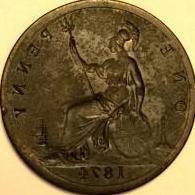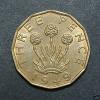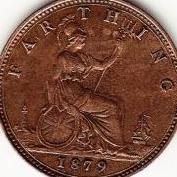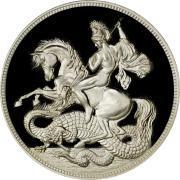Leaderboard
Popular Content
Showing content with the highest reputation on 06/02/2016 in all areas
-
Benjamin Patrick is perhaps best known as the engraver of the Perry Barr Penny token issued by William Booth, the notorious forger who was hanged in 1812. Booth was charged and convicted for forgery of bank notes and coins (the Bank Dollar, 3/- and 1/6) issued by the Bank of England. However this is not Patrick’s only connection with forgery. In a case against the coiner William Henshall, who was transported in 1806 for counterfeiting the Bank Dollar, a Benjamin Patrick (of Phillip’s Salutation Public House in Snow Hill, Birmingham) is mentioned as engraver of counterfeit bank-note plates together with a relative(?) Washington Patrick. I was therefore hoping that the study of the die punches used for the penny token would shed some light on the matter. The original token is unfortunately quite rare and expensive, but thanks to Bente and Paul Withers (Galata) I now have a useful photo. Of Booths counterfeits we know the 1/6 since a hoard of these was discovered in 1956 about half a mile from Booths farm. The Birmingham Museum & Art Gallery also has a Bank Dollar which was found at the farm, only the 3/- remains unidentified. It is possible that Booth also made counterfeits of other coins such as the Third-Guinea, however only the above coins are mentioned in his court case. 1804 BANK DOLLAR Of the 41 counterfeit bank dollars I’ve seen so far; 20 have been cast or produced by transfer dies. The other 21 are milled from engraved dies and of these there are 3 different obverses and 5 reverses. The dies are obvious the work of two different engravers. The letter punches used for the counterfeit Bank Dollar found at Booths farm (below) are of type I. When the large letters of counterfeit I are compared with the large letters used for the Booth token there’s no mistake – the design is exactly the same! All evidence therefore point to Benjamin Patrick as the engraver of both token and counterfeit. The Booth dollar is known only with the same obverse-reverse combination. There is however another obverse combined with 3 different reverses engraved by Patrick. Obverse 1 – Nose to I of Gratia Obverse 2 – Nose to TI of Gratia, leaves of laurel wreath almost touching E of DEI, X of Rex very close to bust Reverse 1 – 8 of 1804 directly under 1st L of Dollar - 2nd S of Shillings points to L of England – N of Shillings points directly to 1st N of England Reverse 2 – 8 of 1804 directly under 1st L of Dollar - 2nd S of Shillings between GL of England Reverse 3 – 8 of 1804 to the right under 1st L of Dollar - 2nd S of Shillings between GL of England Reverse 4 – as reverse 1 but N of Shillings to the left under 1st N of England We know that William Henshall counterfeited the Bank Dollar but according to the article the dies was manufactured by himself – possible by some sort of transfer method? There are several counterfeit bank dollars which design are exactly the same as the genuine coins only the details are somewhat blurred like on a cast coin, perhaps some of these are the product of Henshall? Or perhaps Henshall coins are so scarce that I just haven’t seen any yet? I think the 2nd Patrick obverse, together with reverse 2-4, are likely to have been engraved at the same time as Booths (1810-11) since they are very similar in style. Henshall’s counterfeits were done in 1805 and if Patrick had been the engraver I would expect the dies to be of a somewhat different style. So for now the coiner using the 2nd obverse remains unknown. to be continued... References Peter Lane and Peter Fleig: William Henshall: Maker of NSW Holey Dollars and Dumps (Numismatic Association of Australia - NAAJ 15 2004) Paul and Bente Withers: British copper tokens 1811-1820 The trial at large of William Booth and his associates, George Scot, the three Yates's, John Barrows and Elizabeth Childlow for Forgery, Coining etc. at the Stafford summer assizes, 1812, before Mr. Justice Le Blanc. (Gower and Smart 1812)1 point
-
1 point
-
Agreed! Collecting 50ps is what lead me to where I am today and I'm still collecting them as they come out!1 point
-
I've got a complete set of £2 coins, and no, it doesn't sound strange at all. Eminently sensible in fact, since £2 coins especially, enable would be collectors of currently circulating coins, to obtain some low mintage issues via change in the pocket.1 point
-
1 point
-
I recommend signing up to codecademy.com, it's where I first started out with html5, css, jquery etc. Excellent tool and you will learn a lot even from the free stuff. Depending where you store the info, you might need a little MySQL experience too1 point
-
This thread reminds me actually I picked up a nice filled 2 on a 1920, I'll grab some pictures when I can. The filled part is actually higher than the digit.1 point
-
No I suppose not, although they stopped me from winning it so they got what they deserved löl1 point
-
I.m still unsure as to why they'd even invent an "elite membership" surely if you take an old beaten car to a garage the garage owner won't turn it away just because a Ferrari is sitting next to it, not everyone wants to slab hundreds of coins a year and you have to eat a bit of bread and butter even though you want a steak. They'll be offering special labels next at £20 a pop on top of your grading and elite fees...... Clock is ticking on their downfall, their own stupidity, they think they're all grown up now and can tackle PCGS and NGC1 point
-
@Paulus I am very sorry that I did not see this topic until just now. I have no idea how I missed it, but I only poke my head in every once in a while in the summer months, and I see it was posted in July. Nonetheless, I will post a bit below on my methods. Firstly, let me just say that your pictures have improved a great deal Paulus. You're capturing luster very well in your more recent images, and the focus is also much sharper. I feel a lot of people pay too much attention to the bells and whistles on fancy cameras or purchase really expensive lenses hoping that having the right (i.e., expensive) equipment will somehow make you a better photographer. For coin photography, the most important pieces are often the very inexpensive ones of the equation. Lighting is immensely important - I'd say the most important ingredient for taking good coin images. The type of light bulb (LED, incandescent, fluorescent) you use is less important, but understanding how to use that light source is key. For example, being able to set a custom white balance in your camera for your particular lights is key to getting realistic colors. The size of the light source (small bulb vs. large bulb) or the apparent size of the light source (e.g., a small light source diffused acts like a larger light source) is also important for fully lighting the coin's surface. The angle of the lights changes the appearance of the coin's surfaces a lot -- and your lights should always be placed above your mounted camera lens, if not even higher. With regard to lighting (in particularly angle), I wrote up a little article on the NGC forums some 3+ years ago, and I think it may be helpful. Keep your lights at a high angle to the surface on which the coin is placed, and diffuse them enough or use large enough light point surfaces to avoid hot spots on the coin. See my little schematic below of what my photography rig looks like. Second to lighting, I would say that mounting your camera on a solid copy stand or tripod is very important. Images taken with a hand held camera will be a bit "shaky" or lacking in detail. I have seen hand-held images of coins that get the message across, but the ability to zoom in and see details or inspect surfaces is very limited. Not only is mounting your camera on a sturdy surface important, but it is also important that your camera is aligned to the flat surface of the coin properly. By that I mean, the camera's detector (a small rectangular flat surface at the back of the lens where the image is focused) needs to be perfectly parallel with the coin's surface (i.e., in parallel planes). This is important for focusing reasons. The easiest way to make sure your camera is mounted parallel with the surface on which the coin is placed is to use a little mirror. Place the mirror where you would place the coin, and adjust your camera in the x, y, and z planes as needed until the center of your lens' reflection is perfectly centered in the camera's viewfinder. See the little schematic I created below. Lastly, practice, practice, and practice some more. I have now taken somewhere around 20,000 images of coins over the past 7 years. I have only been happy with my images for the past 4.5 years. It takes a while to get up to "happy" quality -- and I'm still improving my images and tweaking things today. I try to take at least some coin photos 2-3 days of every week. It just keeps me in the "zone". I hope some of these hints help a little. Best, Brandon1 point






